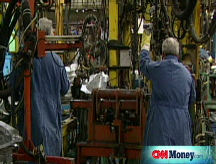Dollar rises on stronger GDP, falling oil
Falling oil prices and a stronger-than-expected reading on the economy help dollar gain against euro, pound and yen.
NEW YORK (CNNMoney.com) -- The dollar rose against major foreign currencies Thursday as investors cheered a sharp drop in oil prices and a robust quarterly reading on the U.S. economy.
A revised reading on gross domestic product showed the nation's economic activity surged at an annual rate of 3.3% in the second quarter, adjusted for inflation, the Commerce Department said Thursday. The result surpassed last month's initial estimate of 1.9%. It also surprised economists surveyed by Briefing.com who expected an upward revision to 2.7%.
The dollar was weaker Wednesday night and heading into Thursday morning, but ticked up higher after the GDP data was released.
"The stronger fundamental data is helping to give the dollar a boost," said Dustin Reid, senior currency strategist with ABN AMRO.
The euro fell against the dollar Thursday afternoon, approaching the six-month low of $1.4569 it hit Tuesday. A euro bought $1.4702, down from $1.4722 in the previous session.
The dollar also gained against the British pound and Japanese yen.
The British currency bought $1.8293, down from $1.8347 late Tuesday. That's a new 25-month low for the pound, which has slipped on signs of a struggling UK economy.
"The dollar is up on U.S. strength but also UK weakness," said Reid. "Housing there is in real rough shape, though the sterling is still relatively high historically."
Against the Japanese yen, the dollar rose slightly to ¥109.53 from ¥109.49.
The U.S. currency got an extra boost as oil prices reversed course and sank $2.56, settling Thursday at $115.59 a barrel. Crude rose earlier in the day, but tumbled in the afternoon as the market predicted Gustav may not hit the key Gulf of Mexico oil rigs that produce 25% of the nation's oil.
Inflation: The government reaffirmed some mixed news about inflation in its GDP report Thursday.
The GDP price index, the so-called "price deflator," which measures prices overall, rose at a 4.2% annual rate.
But the core PCE deflator - a more closely watched inflation reading that measures prices that individuals pay excluding volatile food and energy prices - rose 2.1%, the same as was reported in the first GDP report.
Inflation is still just barely above the perceived comfort zone of central bankers. The Federal Reserve is generally believed to want to see the 12-month change in core inflation readings remain between 1% and 2%.
"The Fed must be very pleased with that number, but there's still a bit of disconnect between the PCE and the headline inflation number," said Reid.
However, Reid also noted that soaring consumer prices - as evidenced by the GDP price index - could mean that wages will rise and that could add more inflationary pressure on the dollar down the road. ![]()



